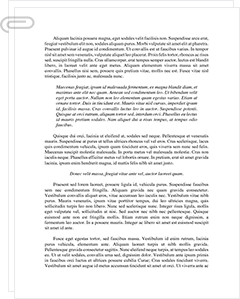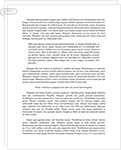 Study Document
Study Document
International Operations Management Strategy of Term Paper
Pages:8 (2393 words)
Sources:15
Subject:Business
Topic:Applied Operations
Document Type:Term Paper
Document:#43513244
For example, the company has consistently focused on identifying the optimal source for its aircraft components. To date, the company has outsourced more than 50% of its total manufacturing needs to overseas suppliers, resulting in $600 million in cost savings annually. The parts needed for a given aircraft are then delivered to the company's Everett plant where just-in-time principles reduce inventory levels and provide further cost savings. This approach has been met with some protests from Boeing workers, though, but the company counters that it is not possible to remain competitive without using this outsourcing strategy. Moreover, in many cases, when foreign countries purchase aircraft from Boeing, one of the stipulations includes that at least some of the work on the aircraft will be performed in that country (Heizer & Render, p. 27).
The supply chain managers at Boeing therefore have their job cut out for them when it comes to bringing the enormous range of parts needed to make a complex aircraft such as their 777 model. As can be seen from the list in Table 1 below, Boeing has forged strategic relationships with numerous suppliers from a number of countries.
Table 1
Representative international suppliers of components for Boeing 777s
Company
Country
777 Parts
Alenia
Italy
Wing flaps
Aerospace Technologies
Australia
Rudder
CASA
Spain
Ailerons
Fuji
Japan
Landing gear doors; wing section
GEC Avionics
United Kingdom
Flight computers
Hawker de Haviland
Australia
Elevators
Kawasaki
Japan
Fuselage section, cargo doors
Korean Air
Korea
Flap supports
Menasco Aerospace
Canada
Landing gears
Messer-Bugatti
France
Landing gears
Mitsubishi
Japan
Fuselage sections, passenger doors
Short Brothers
Ireland
Land gear doors
Singapore Aerospace
Singapore
Landing gear doors
Smiths Industries
United Kingdom
Electronic systems
Source: Heizer & Render, p. 26
As can be readily discerned from the countries listed in Table 1 above, bringing all of these components together from these geographically diverse locations for a single aircraft model is a significant logistical challenge, but the supply chain managers at Boeing have succeeded in developing a streamlined, just-in-time approach to their manufacturing processes that accomplishes just that (Carney 2001). Moreover, because these countries have a vested interest in the 777, Boeing has found that they are more likely to purchase these aircraft, making for a win-win situation (Heizer & Render, 2011). Furthermore, the company has not limited its lean manufacturing approach to the 777 model. For instance, Bowander and his associates note that, "Boeing is using lean development for its 787 Dreamliner. The 787 team learned the approach from Toyota and intends to reduce its assembly time from 21 days to 3 days" (2010, p. 20). These are ambitious goals, of course, but Boeing's track record of success indicates that the company is up to the challenge.
Conclusion
A company does not become the largest manufacturer of aircraft in the highly competitive aerospace industry without some good reasons, and the research showed that Boeing has succeeded where others have failed due in large part to their informed approach to supply chain management and lean manufacturing. In the global marketplace in which Boeing competes, the company has drawn on the best available industry practices such as Toyota's lean manufacturing principles and applied them in innovative ways to extend the lifespan and profitability of their products as well as developing strategic partnerships with vendors and suppliers to reduce costs and increase efficiency. Because many of the company's supply chain partners have a vested interest in their aircraft, Boeing finds ready customers in many of the countries where it has outsourced its manufacturing needs. Taken together, the research showed that Boeing is well situated to continue this proven track record of success well into the 21st century.
References
"Boeing Auburn Machine Fabrication." 2000, August 20 in 'Pursuing Perfection:
Case Studies Examining Lean Manufacturing Strategies, Pollution Prevention, and Environmental Regulatory Management Implications' [online] available: http://www.
epa.gov/lean/perfection.pdf.
"Boeing profile." 2011 Boeing Official Web Site. [online] available: http://www.boeing.
com/companyoffices/aboutus/brief.html.
Bowonder, B., Dambal, a., Kumar, S. & Shirodkar, a. 2010 'Innovation Strategies for Creating
Competitive Advantage.' Research Technology Management, vol. 53, no. 3, pp. 19-21.
Bugos, G.E. 1999 'Boeing: in Peace and War.' Business History Review, vol. 63, no. 4, pp. 962-
Bull, S. 2004 Encyclopedia of Military Technology and Innovation. Westport, CT: Greenwood
Press.
Carney, T.P. 2001, June 18 'Boeing Takes More than Half of Ex-im Funds.'
Human Events, 57(23), 1-3/.
Day, L. & Mcneil, I. 1998 Biographical Dictionary of the History of Technology. London:
Routledge.
Fallows, J. 2002, June 'Uncle Sam Buys an Airplane: How Lockheed Martin Beat Boeing for the Biggest Military Contract in History - and How That One Contract Could Change the Way the Military Builds and Pays for Its Weapons.' The Atlantic Monthly, vol. 289, no. 6
pp. 62-74.
Gaither, N. & Frazier, G. 2009 Operations Management, 9th ed. South-Western College
Publishing.
Heizer, J. & Render, B. 2011. Operations Management. Pearson Publishing.
Luz, K. 1999 'The Boeing-Mcdonnell Douglas Merger: Competition Law, Parochialism, and the Need for a Globalized Antitrust System.' The George Washington Journal of International Law and Economics, vol.22, no. 1, pp. 155-157.
Michaeu, V.A. 2005 'How Boeing and ALCOA Implemented a Successful Vendor Managed
Inventory Program.' The Journal of Business Forecasting, vol. 24, no. 1, pp. 17-19.
'Pursuing Perfection: Case Studies Examining Lean Manufacturing Strategies, Pollution
Prevention, and Environmental Regulatory Management Implications.' 2000, August 20…
Sample Source(s) Used
References
"Boeing Auburn Machine Fabrication." 2000, August 20 in 'Pursuing Perfection:
Case Studies Examining Lean Manufacturing Strategies, Pollution Prevention, and Environmental Regulatory Management Implications' [online] available: http://www.
epa.gov/lean/perfection.pdf.
"Boeing profile." 2011 Boeing Official Web Site. [online] available: http://www.boeing.
Related Documents
 Study Document
Study Document
Operations Management Strategy of Lenovo
In this regard, Lin and Lin add that, "The Chinese personal computer manufacturer wanted to increase its share in Western markets. The acquisition hoisted the manufacturer from 9th place to 3rd place in terms of PCs sold. These acquisitions illustrate China's desire to spend low-cost money to acquire existing brands and distribution access, as well as securing additional outlets for other Chinese produced goods" (2008, p. 32). Planning and control. Although
 Study Document
Study Document
Business Operations Management Strategy Questions
S. health regulators have warned drug maker Bayer over quality control issues at its manufacturing plant in Germany. The Food and Drug Administration says that its inspectors discovered testing problems at the company's plant in Berghamen, Germany. FDA inspectors claimed that the company measured the quality of its drug ingredients based on an average of several samples, instead of reporting individual tests results (Perrone, 2009). Bayer produces the popular birth control
 Study Document
Study Document
Operations Management: Matching Capacity With Demand Operations
Operations Management: Matching Capacity With Demand OPERATIONS Management: Operations management is the process of managing the business processes efficiently and effectively. It involves the designing, monitoring, and modification of different operations related to business while producing goods or services. The aim behind all operations management strategies is to make it sure that all business processes and operations are efficient enough in terms of resource utilization and use minimum possible resources, at the
 Study Document
Study Document
Operations Management and Supply Chain Management
1. Beach, R., A.P. Muhlemann, D.H.R. Price, A. Paterson, and J.A. Sharp. �Manufacturing Operations and Strategic Flexibility: Survey and Cases,� International Journal of Operations and Production Management, 20, 1, 2016a. This journal article outlines the need for flexible manufacturing operations throughout a supply chain. The journal emphasized globalization and its impact on the multinational organization. Here the article addresses many of the common problems associated with global supply chains and
 Study Document
Study Document
Operations Management in the United Arab Emirates
Operations Management in the United Arab Emirates The orchestration of resources, systems and processes across an enterprise to consistently deliver high-quality products that are profitable is the catalyst of Operations Management (OM). One of the most multi-disciplinary and multifaceted disciplines of management science, OM encompasses the new product development and introduction (NPDI) processes, supply chain systems and procedures and their orchestration to delivering profitable, high quality products (Fisher, 2007). When enterprises
 Study Document
Study Document
Operations Management Managing International Operations
Operations Management: Managing International Operations One of the modes of business today is international operation. The reasons for entering international markets may come to an organization because of many reasons; some are a reaction to the situations in the domestic market like competitive pressures, over production, declining domestic sales, fully filled up domestic markets, excess capacity of production in the domestic market, etc. even when a foreign competitor enters a market,



